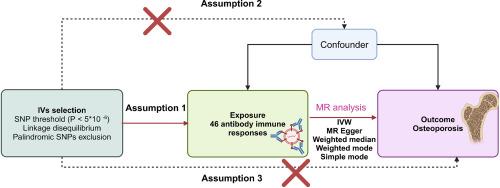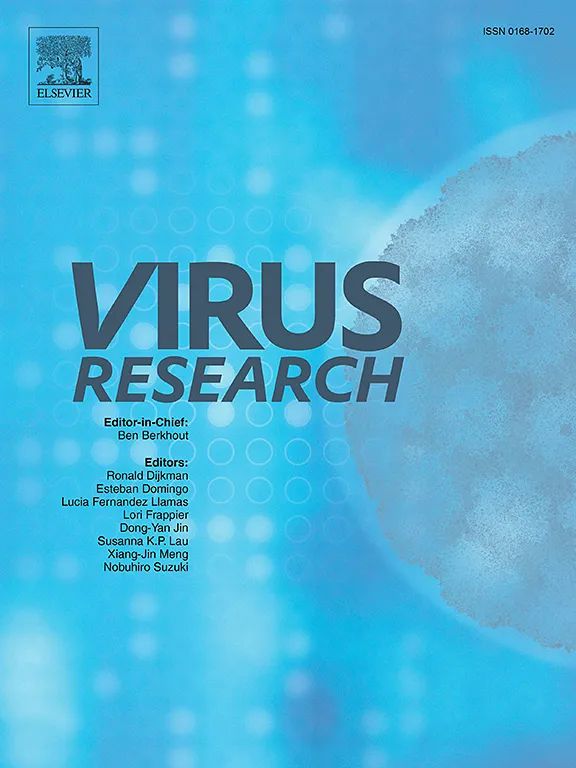免疫介导的骨质流失:一项孟德尔随机化和基于nhanes的病毒感染和骨质疏松症研究。
IF 2.7
4区 医学
Q3 VIROLOGY
引用次数: 0
摘要
骨质疏松症是骨折的主要危险因素,然而免疫反应在其发病机制中的作用仍然知之甚少。本研究探讨了包括eb病毒(EBV)、人类疱疹病毒6 (HHV-6)和水痘带状疱疹病毒(VZV)在内的常见病毒感染是否通过免疫介导的途径导致骨质疏松症。方法:我们使用全基因组关联研究(GWAS)汇总数据进行了两样本孟德尔随机化(MR),并辅以NHANES 2003-2004周期的观察性分析。研究人员检测了EBV、HHV-6和VZV抗体应答对关键骨骼部位骨矿物质密度(BMD)的潜在因果影响。结果:MR分析表明,EBV、HHV-6和VZV抗体反应较强与骨密度降低相关,尤其是腰椎和股骨颈(OR = 1.18,95% CI: 1.02-1.36, p = 0.040)。亚组分析显示,年轻男性EBV患者和老年女性VZV患者的减少更为明显。敏感性测试支持了这些发现的稳健性。结论:我们的研究结果表明,常见的疱疹病毒感染可能通过免疫介导的机制导致骨质流失,特别是在易感亚群中。这些结果为骨质疏松症的病毒免疫联系提供了流行病学支持,并强调了机制和纵向研究的必要性,以阐明潜在的途径并指导未来的预防策略。本文章由计算机程序翻译,如有差异,请以英文原文为准。

Immune-mediated bone loss: A Mendelian randomization and NHANES-based study of viral infections and osteoporosis
Introduction
Osteoporosis is a major risk factor for fractures, yet the contribution of immune responses to its pathogenesis remains poorly understood. This study investigates whether common viral infections, including Epstein–Barr virus (EBV), human herpesvirus 6 (HHV-6), and varicella-zoster virus (VZV), contribute to osteoporosis through immune-mediated pathways.
Methods
We performed two-sample Mendelian randomization (MR) using genome-wide association study (GWAS) summary data and complemented this with observational analyses from the NHANES 2003–2004 cycle. Antibody responses to EBV, HHV-6, and VZV were examined for potential causal effects on bone mineral density (BMD) at key skeletal sites.
Results
MR analyses indicated that stronger antibody responses to EBV, HHV-6, and VZV were associated with reduced BMD, particularly at the lumbar spine and femoral neck (OR = 1.18, 95 % CI: 1.02–1.36, p = 0.040). Subgroup analyses suggested more pronounced reductions among young men with EBV and elderly women with VZV. Sensitivity tests supported the robustness of these findings.
Conclusions
Our findings suggest that common herpesvirus infections may contribute to bone loss via immune-mediated mechanisms, especially in vulnerable subgroups. These results provide epidemiological support for a viral–immune link in osteoporosis and underscore the need for mechanistic and longitudinal studies to clarify underlying pathways and guide future preventive strategies.
求助全文
通过发布文献求助,成功后即可免费获取论文全文。
去求助
来源期刊

Virus research
医学-病毒学
CiteScore
9.50
自引率
2.00%
发文量
239
审稿时长
43 days
期刊介绍:
Virus Research provides a means of fast publication for original papers on fundamental research in virology. Contributions on new developments concerning virus structure, replication, pathogenesis and evolution are encouraged. These include reports describing virus morphology, the function and antigenic analysis of virus structural components, virus genome structure and expression, analysis on virus replication processes, virus evolution in connection with antiviral interventions, effects of viruses on their host cells, particularly on the immune system, and the pathogenesis of virus infections, including oncogene activation and transduction.
 求助内容:
求助内容: 应助结果提醒方式:
应助结果提醒方式:


